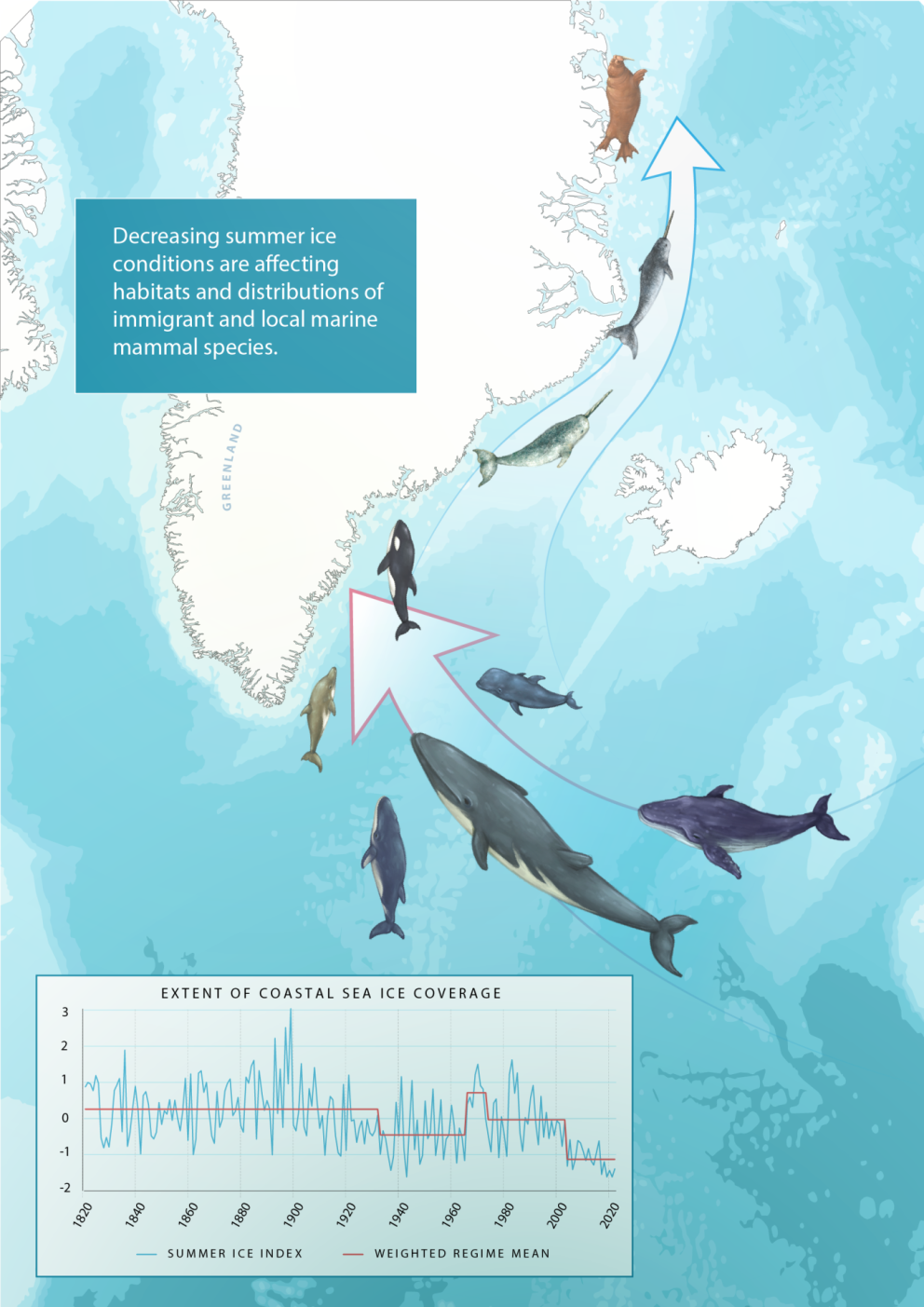- Research
- Fish tagging
- Lumpfish research
- Oceanography
- Seabed mapping
- Arnarfjörður
- Drekasvæði
- Ísafjarðardjúp
- Jökulbanki
- Jökuldjúp
- Kolbeinseyjarhryggur and adjacent area
- Kolluáll
- Langanesgrunn
- Látragrunn
- Nesdjúp
- Reykjaneshryggur and adjacent area
- Selvogsbanki
- South of Selvogsbanki
- South of Skeiðarárdjúp
- South of Skerjadjúp
- Southeast of Lónsdjúp
- Southwest of Jökuldjúp
- Suðausturmið
- Suðurdjúp
- Vesturdjúp
- East of Reykjaneshryggur
- Vestfjardarmid
- Seal research
- Whale Research
- Advice
- About
Regime shift in marine ecosystem off Southeast Greenland
01. December 2022
 Index of sea ice extent at Southeast Greenland 1820 – 2021, and illustration of changes in cetacean distribution during recent years.
Index of sea ice extent at Southeast Greenland 1820 – 2021, and illustration of changes in cetacean distribution during recent years.
Findings of unexpected large numbers of fin and humpback whales during recent years in the previously ice infested waters of East Greenland indicate a tipping point in the marine ecosystem from one regime to another that may be irreversible.
The sub-arctic ecosystem off Southeast Greenland dominated by large amounts of drifting pack ice has changed during this century to a more temperate system with less sea ice and warmer ocean temperatures. These changes in summer ocean conditions are making the region more attractive for large numbers of fin and humpback whales, as well as mackerel, bluefin tuna and other pelagic fish species, while e.g. narwhales and walruses have largely retreated from the region.
Dramatic ecological changes such as these are considered regime shifts in the ecological literature. Shifts from one regime to another occur at a tipping point and may be irreversible. The regime shift has cascading effects throughout the ecosystem.
These are the conclusions in a new scientific study published in the internationally peer-reviewed scientific journal Global Change Biology. The study was led by Mads Peter Heide Jørgensen at the Greenland Institute of Natural Resources, Denmark, in cooperation with researchers from Denmark, Greenland, USA and Iceland. Two coauthors from the Marine and Freshwater Research Institute in Iceland contributed to the study, Gísli Víkingsson, expert on cetaceans, and physical oceanographer Andreas Macrander.
The study combines a vast set of long-term observations, including stock assessment and distribution of whale and fish species, sea ice, and hydrographic data. Data of the Faxaflói 9 station collected over the past 50 years by MFRI during the regular ástand sjávar cruises were used to assess recent changes in temperature and salinity of the Irminger Sea. Mackerel and capelin survey data from MFRI permitted to map changing distribution of pelagic fish corresponding with increasing temperatures of the ocean.
The sea ice retreat off South-East Greenland is unprecedented in the past 200 years of summer ice observations in the region. “The new regime will likely become permanent for the foreseeable future, unless temperatures cool and the ice export from the north increases again. According to recent IPCC reports, continued 21st century climate change make this scenario unlikely,” says Professor Mads Peter Heide-Jørgensen, Greenland Institute of Natural Resources.
The study is part of the EU funded ECOTIP and a Nordic Council project investigating links between changing oceanographic conditions and fisheries in East Greenland (AG-Fisk LEGCO). ECOTIP focuses on tipping elements in the marine environment of the North Atlantic.
Heide-Jørgensen, M. P., Chambault, P., Jansen, T., Gjelstrup, C. V. B., Rosing-Asvid, A., Macrander, A., Víkingsson, G., Zhang, X., Andresen, C. S., & MacKenzie, B. R. (2022). A regime shift in the Southeast Greenland marine ecosystem. Global Change Biology, 00, 1–18.
